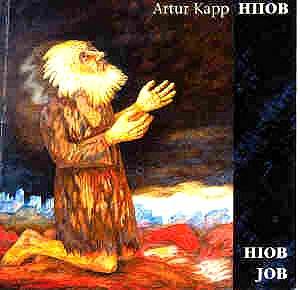This is the world premiere of Arthur Kapp's two-part
oratorio Job. It is here wonderfully presented in 32 tracks.
Kapp was born in the small Estonian town of Suure-Jaani.
He studied in St Petersburg with Rimsky-Korsakov. After spending
some time in Moscow and Astrakhan he returned to Estonia where
he occupied various senior musical positions in the National Theatre.
His most significant works apart from Hiob are the Symphony
No. 1 in F minor (1924), Organ Concerto No. 1 (1934) and symphonic
poem Fate (1939). He is not to be confused with Eduard
Kapp or Willem Kapp. The latter's optimistic Soviet-style Second
Symphony was recorded a couple of years ago on a BBC Music Magazine
cover-mount CD.
It may be helpful to place this work in the context
of other works on the then world stage. Let's look at the period
1929 to 1931 spanning the years in which Kapp completed the oratorio
up to its premiere. 1929 was the year of Roussel's Third Symphony,
Miaskovsky's triptych (Serenade, Sinfonietta and
Lyric Concertino), Randall Thompson's Symphony No. 1, Lambert's
Rio Grande. 1930 brought forth Vaughan Williams' own Job
- a masque for dancing, Smyth's choral symphony The Prison,
Havergal Brian's Second Symphony, Frank Bridge's Oration,
Bax's Winter Legends, Bliss's Morning Heroes and
Hanson's Second Symphony. 1931: Vaughan Williams' Fourth Symphony,
Brian's Third Symphony, Bridge's Phantasm and Szymanowski's
Fourth Symphony.
Kapp's oratorio is more monumental than jazzy;
in fact not jazzy at all; more old-fashioned than revolutionary.
This is a bardic Job with one foot in the gentian blue
fields of Estonia and another in Borodin's Polovtsi palanquins.
It starts as a pastoral idyll - gently rocking
to a harp ostinato. This theme is to dominate in various variants
much of the work's music e.g. the Angel's chorus (tr.28). This
is not at all colossal ... intimate rather. When the men's voices
join (tr.2) the recollection is of Borodin's more contented Polovtsian
moments. The upward and downwards surge of the orchestra may remind
some listeners of the diaphanous filigree of Bax's Garden of
Fand.
Interesting landmarks include the very Tchaikovskian
wind chords at the start of tr. 4 sounding as if they have escaped
from Romeo and Juliet. The Devil (tr.5) has the infernal
flames suggested by the woodwind. The darting theme also has something
of the sea in it. Tracks 6 and 7 can sound jolly - a bit like
a Nordic Stanford. The choir always has a big sound and widespread
concert perspective across the soundstage. There is no lack of
majesty (tr. 7 1.48) with the burnished brass calling out portentously.
A viciously punched-out 'Dies Irae' recalls the
Old Testament blood-fury of Havergal Brian's Das Siegeslied
(Symphony No. 4) and The City Arming from Bliss's Morning
Heroes (both contemporary works). The Sei getruss (tr.12)
is tenderly Brahmsian (alles fleisch) mixed with the more reticent
moments in Howard Hanson's Lament for Beowulf.
Kapp writes music with nationalistic vitality
and plenty of rhythmic fibre and humanity - the plaintive writing
for voice in tr. 26 bears this out. It is not at all modernistic.
The reference points are Taneiev, Brahms, Sibelius (Kullervo)
and Klami (Psalmus). This is not as original or as loveably
impressive a work as Tobias's Jonah Sendung (on Bis)
- another major choral-orchestral piece edited by Rumessen
and conducted by Järvi. However it is far from inconsequential.
It is sung with guts, bite and fire in the belly. This is a blazing
performance which touches on the exalted writing in Verdi's Requiem
and Beethoven's Missa Solemnis.
This is a white-hot performance which the occasional
dropped score, paper rustle or cough does nothing to alloy. It
streams with a self-renewing life force and with a severe fugal
reverence related in the finale to the vocal flames of Beethoven's
Choral Symphony. This is a live concert performance as
the cough at the start of tr. 8 testifies. The blazing singing
of the finale brings the dazzling epiphany of the pastoral prelude
now dressed in burnished and brazen magnificence - an impressive
symphonic consummation that transcends a few nodding moments during
the early stages of Part 2.
Rob Barnett
